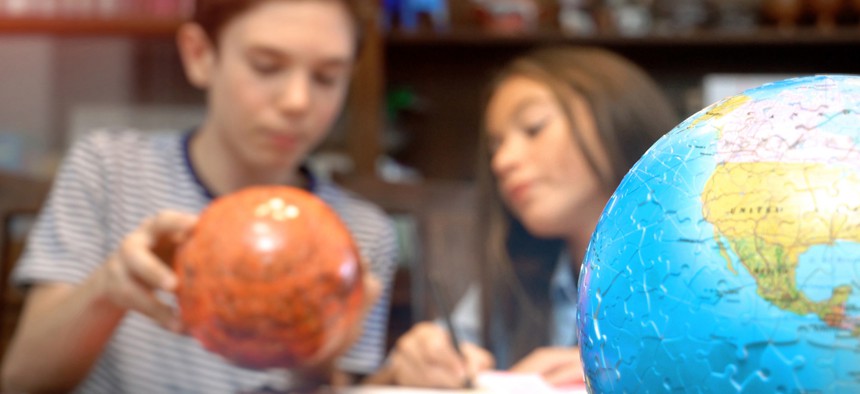Now Available at the Local Library: Basketballs, Air Fryers and Taxidermied Animals

istock.com/101cats
Libraries across the country are diversifying their collections with objects, a growing trend known as the “Library of Things” that aims to help residents learn in new and different ways.
Residents in Wichita, Kansas can swipe their library cards to take home radon detectors and telescopes. In Seattle, they can borrow museum passes. In Ann Arbor, Michigan, library patrons can rent decorative art prints; in Anchorage, Alaska, they can borrow a variety of taxidermied animals.
Those libraries—and dozens of others—have added non-traditional objects to their collections, a growing movement known as the “Library of Things” that aims to enrich residents’ lives in new and innovative ways.
“Libraries lend tools, musical instruments, seeds and other 'unusual' items for the same reason that they lend books,” said Curtis Rogers, a spokesman for the Urban Libraries Council. “It’s to support lifelong learning, entrepreneurial thinking, creativity and skill-building for all community members."
No one officially tracks how many libraries loan items other than books, music and movies, though there are references to a branch in Newark, New Jersey loaning framed paintings as early as 1904, according to the American Library Association. The trend’s expansion has a “clear tie” to the maker movement, a rising interest among consumers to learn to create things, which libraries have embraced since at least 2015 with the addition of technologies like 3-D printers and laser cutters, Rogers said.
But recent collection expansions are more diverse, filled with everyday objects, including board games (Angier, North Carolina), snowshoes (Readfield, Maine) and puzzles, paper shredders, tools and vegetable and flower seeds (Richland County, South Carolina).
Start With Most-requested Items
At the Kalamazoo Public Library in southwestern Michigan, which debuted its Library of Things last week, objects were selected based on survey responses from patrons and input from other libraries that have had success with their collections.
“The things that other libraries had consistent good luck with included sewing machines, air fryers, digital cameras and tool kits,” said Steve Maesen, the library’s circulation manager. “One of our most common requests from patrons is electric power washers. We’re processing requests for water pumps, canopies for outdoor events, tables and chairs, vacuum cleaners, and tools of all sorts and sizes.”
Maesen said the library approached the curation of its collection “intentionally,” buying only items that patrons and community organizations had expressed interest in. When possible, staff tried to purchase only objects that would be accessible for all patrons, including those who travel by public transportation and might not be able to haul a large object home in a car or on foot.
“As we grow the Library of Things, we’re trying to come up with solutions for that, because we have to find a way to get those larger items to patrons,” he said. “For now, we’re trying to keep it to smaller things. An air fryer is a decent-sized item, but it’s light. You could take it on public transportation. It might take up a seat, but you could take it.”
The library began planning the collection two years ago as part of its strategic plan, with approval from its Board of Trustees & Administration. Funding for the project included local grant money and up to $50,000 from the library system’s collection development budget. So far, the library has about a dozen items, with plans to expand to around 50 by the end of the year.
“That’s sort of a rough goal, because a lot of it is really dependent upon what our patrons request,” Maesen said. “A lot of the libraries in Michigan who have grown their collections started small, and now some of them have more than 150 items. It takes a couple of years, but we do want to make it as big as our budget allows.”
Library members check out the items the same way they would a book or a movie, with the addition of a signed lender agreement that stipulates specific terms for each item (an air fryer or an Instant Pot, for example, must be returned clean, with all parts in working order). Staff members examine each item when it comes back in and will usually clean again out of caution before lending it out again, Maesen said.
“Anything that can be put into the dishwasher is put into the dishwasher,” he said. “Camera equipment gets cleaned with special lens cloths, things like that. After they’re clean, we’ll move them along to the next patron.”
The Kalamazoo Public Library does not charge late fees, but if an item is kept 10 days past its due date, the user’s account is placed on hold; after 30 days, they’re automatically billed for the cost to replace the item, though that balance clears if the object is eventually returned in good condition.
Thus far, the most popular items are the air fryers, Canon digital cameras and basic tool kits, Maesen said. Patrons have also checked out games (a beanbag toss, a pingpong set), a sewing machine and a regulation-sized basketball (as of Thursday, a youth-sized basketball remained in stock). Maesen described them all simply as “things people can take home and use,” which he said aligns perfectly with both the traditional and expanding goals of the library.
“Public libraries have always been there to serve the needs of literacy, but we’ve expanded that beyond just books and movies and music,” he said. “There are all sorts of things you can learn. We always say that we try to create community, and we really mean it. This is a way to create community through things—things that our patrons might need and use, and that we can provide for them.”
Kate Elizabeth Queram is a senior reporter for Route Fifty and is based in Washington, D.C.
NEXT STORY: Gov. Andrew Cuomo Resigns





